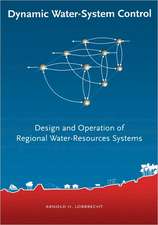Reservoir Sediment Management
Autor Sahnaz Tigrek, Tuce Arasen Limba Engleză Hardback – 15 sep 2011
This volume deals with reservoir sedimentation, deposition and removal. It provides the principles of sediment transport and gives guidelines to predict reservoir life. It presents several removal techniques, accompanied with detailed operation descriptions. With the help of the RESCON open source software, cost analysis tools to determine the optimum method for maintenance and operation of a reservoir can be applied. To illustrate practice and to assist the reader in setting up a sediment management operation, a number of case studies of existing large dams are included.
Written by two experts on reservoir operation, this volume is intended for professionals and advanced students working on dam and reservoir design, construction, operation, maintenance and rehabilitation.
Preț: 710.59 lei
Preț vechi: 953.23 lei
-25% Nou
135.97€ • 142.32$ • 113.17£
Carte tipărită la comandă
Livrare economică 31 martie-14 aprilie
Specificații
ISBN-10: 0415603390
Pagini: 226
Dimensiuni: 174 x 246 x 15 mm
Greutate: 0.57 kg
Ediția:1
Editura: CRC Press
Colecția CRC Press
Public țintă
Postgraduate, Professional, and Professional Practice & DevelopmentCuprins
List of Figures
List of Tables
List of Symbols
Abbreviations
Foreword
Acknowledgment
1 Conceptual framework of reservoir sedimentation
1.1 World reservoir sedimentation
1.2 Changing paradigm from design life approach to a life cycle approach
1.3 Sustainable development of basin water storage capacity
2 Theoretical aspects of sediment transport
2.1 Sediment properties
2.2 Modes of sediment transport
2.3 Siltation mechanism
2.4 Prediction of reservoir deposition
2.4.1 Prediction of the useful life of a reservoir
2.5 Mathematical models
2.5.1 Saint-Venant-Exner equations
2.5.2 Developed methods for the solution of Saint-Venant equations
2.5.3 Developed computer models for aggradation and degradation processes
2.5.3.1 Prediction of delta formation
2.5.4 Application of DELTA
2.5.5 Comparison with the sediment data of Çubuk 1 Dam Reservoir
3 Techniques for preventation of sediment deposition
3.1 Preventing sediment inflow
3.1.1 Watershed management
3.1.2 Upstream check structures (Debris dams)
3.1.3 Reservoir bypass system
3.2 Sustainable management of the dams
3.2.1 Evacuation of sediments from reservoir
3.2.1.1 Flushing
3.2.1.2 Sluicing
3.2.1.3 Density current venting
3.2.1.4 Mechanical removal
3.2.2 Management techniques of sediment within a reservoir
3.3 Lost storage replacement techniques and decommissioning
3.3.1 Raising dam height
3.3.2 Building a new dam
3.3.3 Decommissioning
4 Performance of reservoir conservation model
4.1 The general working principle of RESCON
4.2 Working principle of RESCON for technical optimization
4.2.1 Technical principle of flushing in RESCON
4.2.2 Technical principle of HSRS in RESCON
4.2.3 Traditional dredging and trucking technical principle in RESCON
4.3 Economic optimization working principle of RESCON
4.3.1 Flushing
4.3.2 HSRS 81
4.3.3 Dredging (traditional)
4.3.4 Trucking
4.3.5 Unit cost of the evacuation methods used in RESCON
4.4 Evaluation and comments about economic results of RESCON
5 Cost analyses
5.1 Case studies from Turkey
5.2 Historical background of dam construction in Turkey: Experience, lessons, malpractices
5.2.1 Reservoir sedimentation in Turkey
5.2.2 River basins
5.2.3 Measurement of deposition in reservoir lakes
5.3 Case studies for water supply dams
5.3.1 Economical Parameters in Turkey for case studies
5.3.2 Selection criteria for dams
5.3.3 Domestic water supply dam, Çubuk Dam-I
5.3.4 Irrigation water supply dam, Ivriz Dam
5.4 Case studies for hydropower dams
5.4.1 General overview of Coruh Basin Project
5.4.1.1 Muratlı dam
6 Sensitivity analysis of RESCON
6.1 Unit value of the reservoir yield
6.2 Discount rate
6.3 Market interest rate
6.4 Salvage value
6.5 Discussions about RESCON input values
6.5.1 Unit Benefit of Reservoir Yield (P1)
6.5.2 Total cost of dam construction
6.5.3 Salvage value
6.6 Strength and limitations of RESCON
References
Appendix
Subject Index
Notă biografică
Dr Sahnaz Tigrek is Assistant Professor at the Hydromechanics Laboratory of the Middle East Technical University in Ankara. She has received her MSc from the same institute and was awarded her Phd degree for her work in Civil Engineering at the Coastal Engineering Laboratory of Tokyo University, Japan. She worked previously as an engineer in the Ocean and River Engineering Consulting Company in Japan. Her research interests are Computational Fluid Mechanics, Numerical Modeling of Turbulent Flow, Boundary Layer Flow, Flow Measurements in Open Channels, Sedimentation, Reservoir Sustainability in Water Resources Projects, Design of Diffusers.
Tuce Aras is currently working at EKON Industry Construction & Trade Inc. as a proposal engineer. She received her MSc degree in Civil Engineering from the Middle East Technical University in Ankara, Turkey, where studied reservoir sediment management with Dr. Sahnaz Tigrek.
Descriere
Siltation in reservoirs has become an important problem when dams are getting older and stop functioning when the sediment has accumulated to a certain extent. With proper sediment management techniques, negative effects of sediment can be avoided and reservoir life and performance can be improved.
This volume deals with reservoir sedimentation, deposition and removal. It provides the principles of sediment transport and gives guidelines to predict reservoir life. It presents several removal techniques, accompanied with detailed operation descriptions. With the help of the RESCON open source software, cost analysis tools to determine the optimum method for maintenance and operation of a reservoir can be applied. To illustrate practice and to assist the reader in setting up a sediment management operation, a number of case studies of existing large dams are included.
Written by two experts on reservoir operation, this volume is intended for professionals and advanced students working on dam and reservoir design, construction, operation, maintenance and rehabilitation.





















